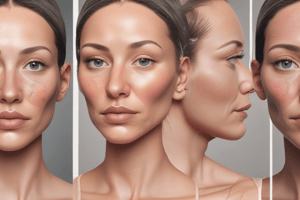Podcast
Questions and Answers
What is the primary focus of plastic surgery?
What is the primary focus of plastic surgery?
- Restoration and enhancement of body structures (correct)
- Surgical treatment of heart diseases
- Repair of musculoskeletal injuries
- Management of gastrointestinal disorders
Which procedure is commonly performed in cardiothoracic surgery?
Which procedure is commonly performed in cardiothoracic surgery?
- Coronary Artery Bypass Grafting (CABG) (correct)
- Appendectomy
- Joint Replacement Surgery
- Fracture Management
In general surgery, what does a cholecystectomy involve?
In general surgery, what does a cholecystectomy involve?
- Surgery of the spine
- Repair of hernias
- Gallbladder removal (correct)
- Removal of the appendix
What is a critical consideration in orthopedic surgery?
What is a critical consideration in orthopedic surgery?
Which of the following is a common procedure in neurosurgery?
Which of the following is a common procedure in neurosurgery?
What is the main goal of reconstructive surgery within plastic surgery?
What is the main goal of reconstructive surgery within plastic surgery?
What type of surgery involves the removal of part or all of a lung, often due to cancer?
What type of surgery involves the removal of part or all of a lung, often due to cancer?
Which surgical procedure is used to stabilize the spine in neurosurgery?
Which surgical procedure is used to stabilize the spine in neurosurgery?
Flashcards are hidden until you start studying
Study Notes
Surgery
Plastic Surgery
- Focus: Reconstruction and aesthetic enhancement of body structures.
- Types:
- Reconstructive Surgery: Restores form and function (e.g., after trauma, burns).
- Cosmetic Surgery: Enhances appearance (e.g., facelifts, breast augmentation).
- Techniques: Use of grafts, flaps, implants.
- Key Considerations: Patient safety, aesthetic goals, and psychological impact.
Cardiothoracic Surgery
- Focus: Surgical treatment of diseases affecting the heart, lungs, and thoracic cavity.
- Common Procedures:
- Coronary Artery Bypass Grafting (CABG): Bypasses blocked coronary arteries.
- Valve Repair/Replacements: Addresses heart valve dysfunction.
- Lung Resection: Removal of part or all of a lung for cancer.
- Skills Required: Proficiency in cardiopulmonary bypass technology and thoracic anatomy.
General Surgery
- Focus: Variety of abdominal conditions and surgeries.
- Common Procedures:
- Appendectomy: Removal of the appendix.
- Cholecystectomy: Gallbladder removal due to gallstones.
- Hernia Repair: Correction of hernias in the abdominal wall.
- Areas of Expertise: Gastrointestinal tract, endocrine system, and soft tissue.
- Role: May involve preoperative and postoperative care, including patient management and surgical techniques.
Orthopedic Surgery
- Focus: Conditions related to the musculoskeletal system.
- Common Procedures:
- Joint Replacement Surgery: Replaces damaged joints with artificial implants.
- Fracture Management: Stabilization and repair of broken bones.
- Spinal Surgery: Addresses issues like herniated discs and spinal stenosis.
- Key Considerations: Rehabilitation, pain management, and prevention of complications.
Neurosurgery
- Focus: Surgical treatment of the nervous system, including the brain and spinal cord.
- Common Procedures:
- Craniotomy: Surgical opening of the skull to access the brain.
- Spinal Fusion: Stabilization of the spine to treat conditions like scoliosis.
- Tumor Resection: Removal of brain or spinal tumors.
- Skills Required: Expertise in neuroanatomy and advanced imaging techniques.
- Patient Care: Neurocritical care post-surgery is often essential for recovery.
Plastic Surgery
- Focuses on restoring or enhancing the appearance and function of body structures
- Two main categories: reconstructive and cosmetic surgery
- Reconstructive surgery repairs deformities caused by trauma, burns, or congenital conditions
- Cosmetic surgery aims to improve appearance by enhancing features
- Techniques involve grafts, flaps, and implants to achieve desired outcomes
- Prioritizes patient safety, aesthetic goals, and the psychological impact of procedures
Cardiothoracic Surgery
- Specializes in surgical treatment of diseases affecting the heart, lungs, and chest cavity
- Common procedures include coronary artery bypass grafting, valve repair or replacement, and lung resection
- Coronary artery bypass grafting bypasses blocked arteries to improve blood flow to the heart
- Valve repair or replacement addresses heart valve dysfunction
- Lung resection involves removing part or all of the lung, often for cancer treatment
- Requires proficiency in cardiopulmonary bypass technology and in-depth knowledge of thoracic anatomy
General Surgery
- Covers a wide range of abdominal conditions and surgeries
- Common procedures include appendectomy, cholecystectomy, and hernia repair
- Appendectomy removes the appendix when inflamed.
- Cholecystectomy removes the gallbladder, often for gallstones.
- Hernia repair corrects hernias in the abdominal wall.
- Specializes in the gastrointestinal tract, endocrine system, and soft tissues
- Plays a role in pre- and postoperative care, including patient management and surgical technique
Orthopedic Surgery
- Addresses conditions related to the musculoskeletal system, including bones, joints, and muscles
- Common procedures include joint replacement surgery, fracture management, and spinal surgery
- Joint replacement surgery replaces damaged joints with artificial implants.
- Fracture management involves stabilizing and repairing broken bones.
- Spinal surgery addresses issues like herniated discs and spinal stenosis.
- Focuses on rehabilitation, pain management, and prevention of complications.
Neurosurgery
- Specializes in surgical treatment of the nervous system, including the brain and spinal cord
- Common procedures include craniotomy, spinal fusion, and tumor resection
- Craniotomy involves surgically opening the skull to access the brain.
- Spinal fusion stabilizes the spine to treat conditions like scoliosis.
- Tumor resection involves removing brain or spinal tumors.
- Requires extensive knowledge of neuroanatomy and advanced imaging techniques
- Patient care often includes neurocritical care post-surgery, which is essential for recovery.
Studying That Suits You
Use AI to generate personalized quizzes and flashcards to suit your learning preferences.




